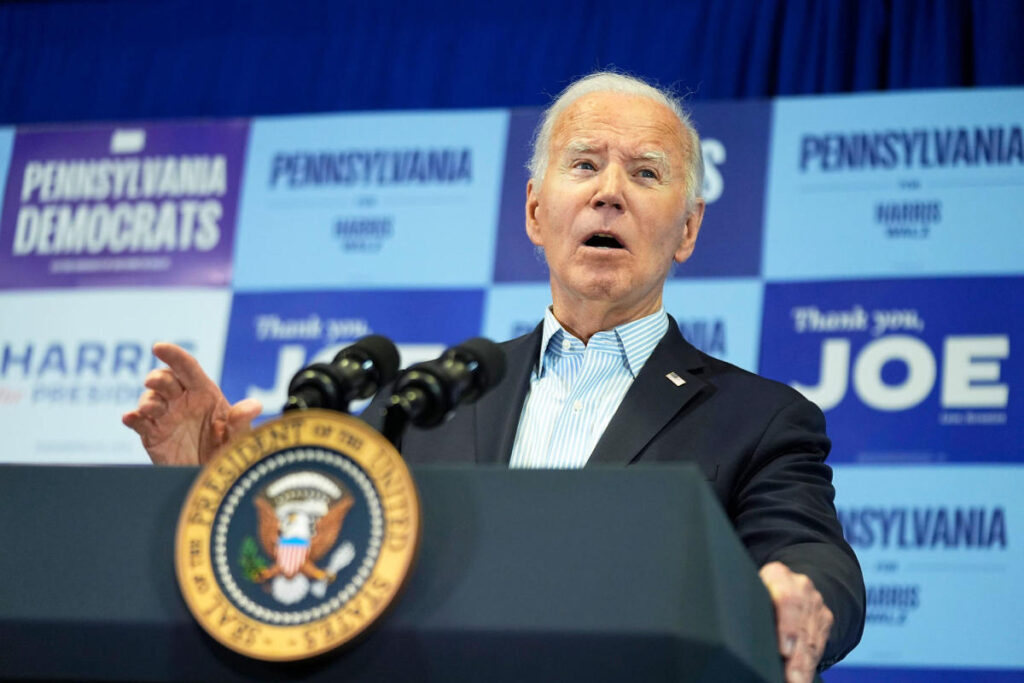President Joe Biden’s journey in the 2024 campaign culminated in a visit to a carpenters’ union hall in Scranton, Pennsylvania, where he took on a surrogate role rather than his previous position as the lead candidate. This appearance marked a stark contrast to the high-energy announcement of his candidacy in April 2023 when he confidently proclaimed his intentions amidst union supporters. Instead of receiving the limelight, Biden’s speech was comparatively muted, overshadowed by simultaneous rallies for Vice President Kamala Harris and former President Donald Trump. The tone was sentimental rather than defiant, with Biden even expressing a sense of humility by stating, “I’m nothing special,” which prompted supportive chants from the crowd, highlighting both his vulnerability and the audience’s desire to uplift him.
As Biden navigates the conclusion of his election campaign, administration officials express hope that this phase will allow the president to execute his remaining duties with greater freedom. The presence of Vice President Harris on the top of the ticket has necessitated a constant coordination between the two, with Biden often checking in on decisions with his vice president’s team. As Biden ended his candidacy in July, he communicated to his staff a desire for the remaining months of his presidency to be productive, and plans were set for initiatives aimed at fortifying his legacy while bolstering Harris’ campaign.
While Biden originally envisioned a robust role in rallying support for Harris during the campaign, his contributions have largely been constrained to targeted events focused on labor and unions. White House officials are keen to accelerate the implementation of Biden’s domestic policy achievements, while his national security team has had more opportunity to engage him directly on foreign policy matters. Conversations are underway regarding how his final days in office will unfold, including possible symbolic gestures that resonate with his journey as a public servant.
The president’s recent public engagements have predominantly revolved around remarks aimed at Trump, as he confronts the repercussions of his off-script comments and their accompanying challenges. Biden reflects on concerns conveyed to him by international leaders who express fears over the potential of Trump regaining power, articulating the stakes involved in what he describes as a battle for democracy. Despite feeling sidelined, Biden imbues his speeches with a tempered optimism, encouraging supporters to rally and take action in the imminent election.
In contrast to Biden’s limited campaign involvement, First Lady Jill Biden has emerged as a dynamic force among campaign surrogates, actively participating in numerous events across battleground states. Her advocacy for Harris reflects both her personal campaign style and an effort to highlight generational change in leadership. Jill Biden points to tangible improvements compared to four years ago, employing her platform to counter the critiques emanating from Trump’s campaign, particularly around the pandemic and societal upheaval experienced during his presidency.
As the final day of the campaign approaches, both Harris and Jill Biden strive to galvanize their base while navigating the intricate dynamics of the political landscape. Harris’ event in Scranton notably lacked direct references to either Trump or Biden, suggesting a strategized distancing that may resonate with voters seeking change. Meanwhile, Jill Biden continues her travels to fortify support for Harris across critical states, wrapping up her campaign efforts as the administration pivots towards executing its agenda in the final chapter of Biden’s presidency. The contrasting roles of Biden and his wife reveal a multifaceted approach to the campaign, validly addressing the electorate while also spotlighting the broader themes of legacy and leadership.

